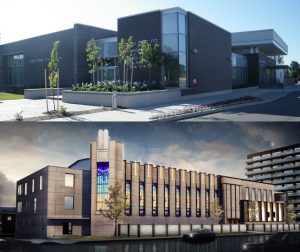I am embarrassed to admit that despite growing up in Montreal alongside a substantial Moroccan Jewish community, I remain largely uninformed about Moroccan Jewish culture. The little that I do know comes from art.
As a curator, I have been lucky to work with two Canadian photographers who turned their lens on Jewish sites across Morocco. Between 1993 and 1999, Montreal’s D.R. Cowles travelled extensively in Morocco. A decade later, Winnipeg-born, Toronto-based Aaron Vincent Elkaim visited the birthplace of his father and his father’s family, who left in the 1960s, like so many Moroccan Jews who call Canada home.
READ: VISITING JEWISH HISTORY THROUGH THE ARTS IN NEW YORK
Cowles’ detailed architectural images printed in deep sepia tones depict ornate interiors of synagogues, passageways of the mellahs – the one-time Jewish quarters – and shrines built at the tombs of revered rabbis known as tzaddikim and venerated as miracle workers. The photographs reveal a way of life and the cultural richness that imbued a community dating back to the destruction of the Second Temple and the later influx of Jews from Spain in 1492.
The pictures also show the impact of the emptying out of Morocco’s Jewish communities after the creation of the State of Israel in images of crumbling synagogues, cemeteries filled with broken stones, and holy sites turned over to other uses such as the El Fessaine synagogue in Fez, which was a sports centre at the time of Cowles’ visit. Once the largest Jewish community in the Arab world, numbering over 250,000, today’s population is roughly 4,000.
But more notable than capturing the dissolution of Jewish communities, Cowles’ and Elkaim’s photographs depict what continues to be preserved despite the shrinking numbers. Elkaim brings his photojournalist eye to an exploration of his Jewish roots, taking particular interest in the Muslim caretakers of Jewish sites that he encountered, through stark yet moving portraits of those entrusted by their departing Jewish neighbours to care for their sacred spaces.
Elkaim’s portfolio, which he calls A Co-Existence, draws out the harmonious relationships that long existed between Jews and Muslims in Morocco, a reminder that present-day animosities in parts of the Arab world are neither universal nor necessarily age-old. A picture of a Mimouna celebration at the home of a family in Casablanca – currently on display in Toronto in an exhibition that I curated at Makom (402 College Street) – is a reminder of how Jewish and Arab neighbours would come together for the festival at the conclusion of the Passover holiday.
From the photographs, I also learned about the Moroccan Jewish practice of making pilgrimages to tombs of tzaddikim. Moroccans return in numbers from Israel, France and North America for the annual hiloula (pilgrimage festivals), where there are often multi-day gatherings filled with prayer, feasting communally and sleeping near the holy site.
READ: HOW A RARE SUPERMAN SKETCH ARRIVED AT THE ONTARIO JEWISH ARCHIVES
For me, these photographic portfolios have been an entry point to an understanding of a vibrant Jewish community that should be more familiar. The artwork offers a gateway to a place that I may never visit, as well as a record of Jewish life that is rapidly changing, transformed, in some cases, even since the picture was made. Still, learning from these captivating bodies of work should also be a catalyst for engaging on a more personal level with the Moroccan communities that are part of the Canadian Jewish community.
In my Jewish schooling in Montreal, I was raised on the notion of “Am echad, lev echad” – that the Jewish People are one nation with one heart. It is a vacant motto unless it is animated with real relationships and more than a cursory understanding of each other. The interconnectedness that Cowles’ and Elkaim’s photographs reveal between Muslims and Jews in Morocco should be a model for Ashkenazi and Sephardi Jewish communities in Canada to be actively curious about the beliefs, practices and lives of Jews that differ from one’s own. Only then will the potential of one nation with one heart be fulfilled.
For more information on visitor hours for the exhibition A Co-Existence, click here.
Evelyn Tauben is a producer, curator and writer in Toronto.






